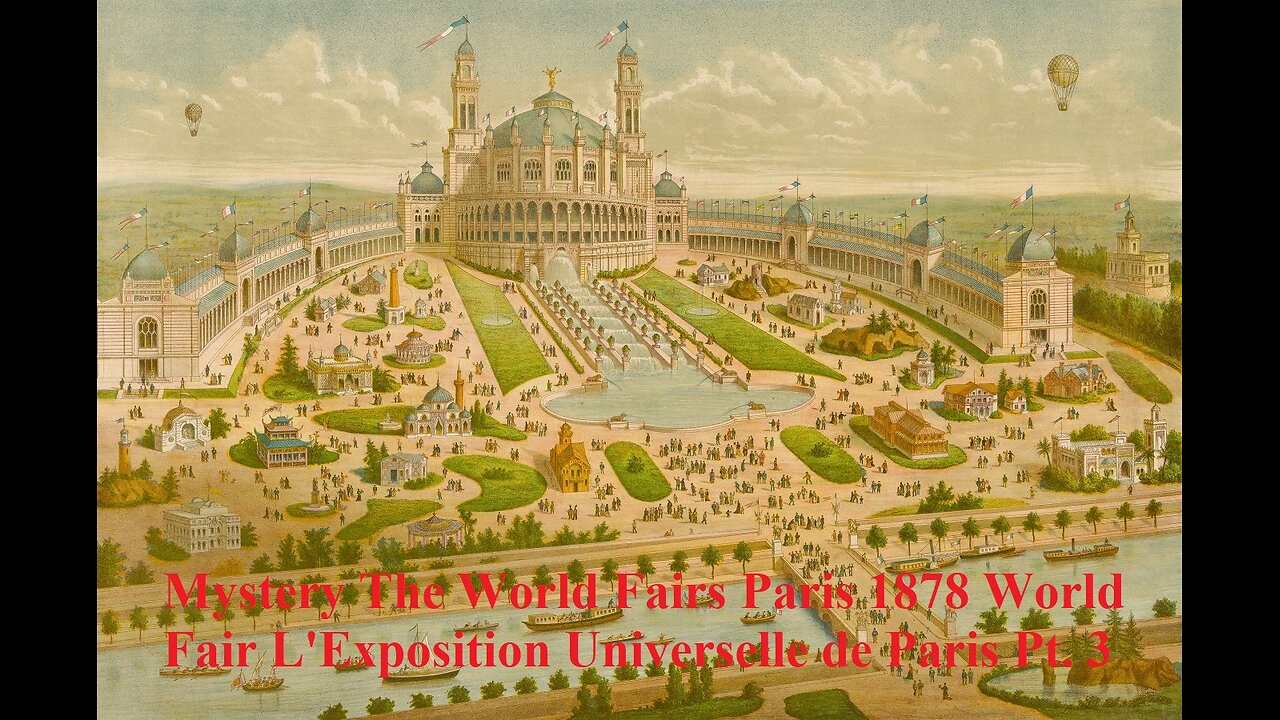Premium Only Content

Mystery The World's Fairs Paris 1878 World's Fair L'Exposition Universelle de Paris # 3
Mystery The World's Fairs Maybe the History we've been told is a lie! Were some ancient buildings built by a different race and their true history was covered up? Did ancient peoples have advanced forms of technology that have now been forgotten ? Was the massive kingdom of Tartaria visible on ancient maps much more advanced than we realize? This sub is an open forum for collaborative discussion of all topics "Tartaria" related, including Mud Flood, Tesla, AntiquiTech, Free Energy, Conspiracies, Hidden History, etc.
I wonder if this video has been posted here before? If yes, then i am not sorry for posting it again, because its just one helluva epic video. If not, I highly recommend watching it if you are interested in perhaps how Tartarian technology worked. I am still thinking about all the stuff he said and points out to us. As its a lot to deal with and can shake one up. I find it fascinating though.
Could it be that this civilization, split off from our official historical line of development, is behind many of the events of the 20th century?
And what of the World's Fairs? Were a large proportion of the World's Fair Buildings actually built from scratch, as the official historiography claims? There is much to suggest that the robber barons of the industrial age not only hid once widespread technological knowledge from us, but that they also hijacked some of the impressive architectural masterpieces in which parts of this knowledge was displayed.
Some of the buildings from the World's Fairs still exist today, and they are obviously not made of plaster or similar fragile materials. Were they subsequently rebuilt to be permanent structures? Is it even possible that the elaborately designed Expo sites were built with the technological capabilities of the time within just a few months, only to be destroyed again a few months later after the exhibitions had ended? Or is it plausible that after a great catastrophe the worldwide remains of the preceding high culture were not only systematically destroyed, but also pressed into an image of history imposed on us?
Some available information suggests that even after the worldwide, game-changing event we call the Reset or Mud Flood, there still remained countless complete and beautiful cities that were conquered by a new power elite and then repurposed as "World's Fairs".
Especially in America, the so-called New World, the many Greco-Roman cities would have been difficult to explain because in contrast to Europe, the Americas do not have an official greco-roman history.
The more carefully one investigates, the more difficult it becomes to find plausible explanations for the construction and destruction of these extraordinary and huge exhibition areas.
The official version about the World's Fairs can be summarized as follows: People in the 19th century loved Greco-Roman architecture for reasons unknown, so it was extremely important to the architects who organized the World's Fairs between 1850 and about 1914 to build in a classical style.
(Note: With World War I, classical architectural ambitions in Europe ended abruptly and many exhibitions also did not take place as planned. It was only in the wake of fascism that there was a return to ancient design principles, but these were often implemented superficially and were mainly applied to a few representative magnificent buildings. After the Second World War, on the other hand, classical architecture was deliberately replaced with new trends - e.g. Bauhaus and Brutalism. Officially the intention was to create an aesthetic distance to fascism, but in all likelihood its purpose was to cut the connection to the Old World through soulless, brutalistic architecture.)
No effort was spared for the world's fairs, enormous amounts of work went into creating complex statues, ornaments, columns, parks, buildings, and even the world's largest organs. No expenses were spared in the making of these massive structures. Made of plaster and linen or hemp fibers, they were only intended to last for the duration of the Expo. However the attention to detail was so great that purely visually there seemed to be no difference between the Expo buildings and the classical splendor-buildings of antiquity. The purpose of the World's Fairs was to make the supposedly "new" technologies discovered during the Industrial Revolution palatable to the masses, to create new markets. In the end, most of the buildings were torn down, with only meadows or empty parks remaining..
How Many World Fairs Did Paris Host in the 19th Century? World Fairs were significant events during the 19th century, and the legendary fairs in Paris showcased artistic and industrial excellence. The 19th century was a momentous period in Parisian history, when significant breakthroughs in art, industry and science were made. One of the most outward expressions of Parisian success were the Paris World Fairs, which cemented the city’s place as a world-leading political capital. These vast events spread out across the entire city and included new temporary and permanent buildings, along with displays of industrial developments and works of art from around the world. Some of the highlights of the Paris World Fairs even went on to become iconic, permanent landmarks, including the Eiffel Tower, and the head of the Statue of Liberty, which later made its way to the United States. Below are the five Paris World Fairs that altered the course of history. 1. The First Paris World Fair: 1855 The very first Paris World Fair took place in 1855. It was organized by Emperor Napoleon III as a promotional tool to assert his new position in power, signifying a landmark moment in France’s history. The World Fair centered around a brand-new exhibition hall – the Palais de l’Industrie on the Champs Elysees. Two new smaller buildings also accompanied this space – the Galerie des Machines and the Palais des Beaux-Arts. Inside these exhibition rooms were a series of world-renowned exhibits dedicated to industry. Meanwhile, a temporary construction next to the Galerie des Machines was designed by the architect Hector LeFuel to house artworks from around the world.
2. The Fair of 1867 The second World Fair in Paris was also organized by Napoleon III to take place in 1867. Again, the event was a powerful strategic move, aimed at bringing attention and political gain to Paris. The main exhibition space for the 1867 Paris World Fair was the Palais du Champ-de-Mars, built by Frederic LePlay, with help from the up-and-coming engineer Gustave Eiffel. This exhibition hall was circular in design, and the fair designers took advantage of this layout, arranging industrial exhibits in the outer circles, while the inner circles were dedicated to art. In the center, a small building housed a display dedicated to currency and coins from around the world. It was a momentous event, larger than the previous one, with a series of pavilions, restaurants and amusement parks constructed around the central building to draw huge crowds.
3. Paris World Fair of 1878 By contrast, the 1878 Paris World Fair took place in a very different political climate. Against the backdrop of the Prussian War, the Paris commune and the downfall of the empire, France was in a vulnerable and unstable state. The officials of the Third Republic decided that a World Fair could bolster France’s popularity on the international stage, even if they could barely afford it. One of the highlights of the fair was the recently completed Head of the Statue of Liberty, which went on display for a brief spell in a Parisian park before being shipped to the United States. Other highlights included the temporary construction of the Palais du Champ-du-Mars (Gustave Eiffel helped with its design!), and the permanent Palais du Trocadero, which later became a concert hall.
4. 1889: The Year of the Eiffel Tower The 1889 Paris World Fair was the second to take place in a republican regime in France. It was a historically significant year for France, marking the 100th anniversary of the French Revolution, so the pressure was on to create something spectacular. The fair was larger and more ambitious than in previous years, taking place in the Palais du Trocadero and the Champ-de-Mars, while several temporary pavilions and pop-up spaces formed satellites around it. Meanwhile, East of the main site, the Esplanade des Invalides showcased a display dedicated to colonial art. But by far the greatest and most controversial aspect of the fair was the unveiling of the Eiffel Tower, which divided public opinions and caused an international sensation. Only meant to be temporary for 20 years, the tower is now an iconic landmark for the city.
5. The Grand Event in 1900 The fifth World Fair in Paris was in 1900, a centenary display of epic and ambitious proportions. Paris was also hosting the Olympic Games in the same year, making the city the center of public attention around the world. A series of new buildings popped up, including the Grand Palais and the Petit Palais, while the government extended the Esplanade des Invalides and Petit Palais. They even painted the Eiffel Tower bright yellow to mark the occasion! A series of visitor attractions pulled in tourists far and wide – these included moving walkways (trottoirs roulants), the Electricity Palace, and a series of night-time water and light displays to dazzle the public at the dawn of a new age.
PARIS, FRANCE 1878
Exposition Universelle
Dates Open - May 1 - November 10, 1878, including Sundays. Open 194 days.
Attendance - Paid Attendance 12,623,847, Total Visitors 13,209,909, Total Attendance (including staff) - 16,159,719.
International Participants - 44 nations and 22 colonies .
Total Cost - 55,389,961 francs ($11,054,330).
Site Acreage - 192 acres of Champ de Mars on one bank of the Seine and Trocadero Hill on the other.
Sanction and Type - Prior to the Bureau of International Exhibitions. Paris 1878 would be considered a medium scale registered event today.
Ticket Cost - Adult Admission Price (1 franc) $0.20, Per Capita Price - $0.191 (Total visitors), $0.156 (Total attendance). Price of season ticket 100 francs.
The third Universelle Exposition in Paris, known as the Exhibition of the Works of Art and Industry of all Nations, followed in the footsteps of the previous two. It was held on one hundred and ninety-two acres on both side of the Seine River, of which seventy of them were covered in exhibit halls around the site. There were fifty-two thousand exhibitors, about half French and the other international. And what were its stars? How about the phonograph, typewriter, and the refrigerator.
It was a difficult fair for France to host, as the losses in the war left the Third Republic with little extra money as they rebuilt from the 1870-1 conflict. There were also questions about pending conflicts; one clue to that, Germany was not exhibiting and it was now a coordinated nation. So, it was natural that the 1878 exposition was a more serious affair than that of 1867, although it did have its whimsy. Sixty-one thousand gallons of water cascaded down the southeast face of Trocadero Hill to the river ever hour. The head of the Statue of Liberty, Bartholdi's Light was exhibited outside the main building as it waited to be shipped to New York.
Exhibitors and hotel keepers were delighted at the larger fair than that of 1867, despite the cost. Of course, there were other detractors past those worried about money. The clergy urged the public to stay away, stating that the opening ceremony was without religion.
Above photo. Gallery D'Iena, Paris Exposition 1878. Below: Advertisement for Glycerine toothe paste, a Gold Medal winner at the Paris Exposition Universelle 1878, 1889. Photos courtesy Wikipedia Commons.
The main building, the Palace of Industry, was a temporary structure two thousand one hundred and thirty-two feet long by one thousand one hundred and forty-eight feet wide. It included the Rue de Nations, where facades led to national displays, returning to the traditional idea of a single building instead of national pavilions for the majority of exhibits, except for a few small pavilions outside. The Fine Arts Building, the Trocadero, was a lavish permanent structure. From the Trocadero to the Seine was the Parc where fountains, restaurants, an aquarium, and foreign pavilions, including Egypt, Algeria, Tunisia, Morocco, Persia, China, Japan, Norway, and Sweden were located. Other pavs on the eastern edge of the Palace of Industry were Netherlands, Portugal, Denmark, Belgium, Switzerland, Russia, Austria-Hungary, Italy, England, Spain and the United States.
The total number of of biuldings was twenty-five, including two major exhibit halls, seventeen national pavilions, two commercial exhibitor buildings, one art palaces, one colonial pavilion and it did have agricultural and livestock displays.
The fair did not turn a profit, even after the Trocadero was sold. Many thought it was worth it, after the Franco Prussian War eight years before and the political changes to the Third Republic, to prove that the new regime could put on such a show and that they were still in the forefront of nations despite the defeat to Germany. It also had the effect of calming the nation after the political upheavals in 1877.
Who Came to the Fair?
The New York Times stated on November 21, 1878, that the number of visitors since May 1 to Paris (per lodging records, not including staying with friends, relatives, etc.) was a total of 203,157. United States 13,573. English 58,916, Germany 21,788, Austria 8,501, Belgium 28,830, Algeria 1382, Bolivia 54, Brazil 1164, Canada 719, China 81, Columbia 156, Chilie 81, French Colonies 795, Costa Rica 39, Denmark 1707, Egypt 659, Ecuador 53, Spain 10,004, Greece 854, Guat. 42, Hond. 13, Neth. 6682, India 386, Italy 14,968, Japan 163, Lux. 2238, Morocco 68, Mexico 1409, Nic., 11, Paraguay 11, Oceania 69, Peru 186, Persia 83, Pa Plata 18, Poland 1952, Port. 1687, Romania 1442, Russia 5725, San Salvador 45, Sweden/Norway 2705, Swiss 11,980, Tunisian 96, Turkey 898, Uruguay 16, Venezuela 148, 1674 others.
Heads of state also came. The procession on opening day included the Prince of Wales and Queen Isabella. The Crown Prince of Denmark attended later.
International Participants
Nations and Colonies
United States, France, Great Britain, Algeria (COL-FRANCE), Andorre, Annam (COL-FRANCE), Argentine Republic, Austro-Hungary, Belgium, Bolivia, China, Cochin China (COL-FRANCE), Denmark, Egpyt, French Guinea (COL-FRANCE), French India (COL-FRANCE), Gaboon (COL-FRANCE), Germany, Greece, Gaudaluope (COL-FRANCE), Guatemala, Hayti, Italy, Japan, Luxembourg, Madagascar, Martinique (COL-FRANCE), Mexico, Morroco, Netherlands, New Caledonia (COL-FRANCE), Nicaragua, Norway w/Sweden, Nossi Be, Persia (the Shah), Peru, Portugal, Reunion (COL-FRANCE), Russia, San Marino, San Salvador, Senegal (COL-FRANCE), Siam (the King), Spain, Sweden (See above w/Norway), Switzerland, Tahiti (COL-FRANCE), Tunis, Uruguay, Venezuela, India (COL-GBRIT), St. Martin (COL-NETH.), Brazil, Monaco, Canada, Turkey, New South Wales (COL-GBRIT), Victoria (COL-GB), Mauritius (COL-GB), South Australia (COL-GBRIT), Cape of Good Hope (C-GBRIT), Portuguese colonies (COL-PORTUGAL), Cambodia (COL-FRANCE), St. Peter's & Michael (COL-FRANCE), Finland (w/Russia), Serbia, Romania.
Expo Tidbits
Gustav Eiffel designed the roof of the main entrance and the side pavilions.
Two innovations at the fair included rails under the floors which were used to bring in and take out exhibits easily, plus a better ventilation system, which was also beneath the floor.
Thomas Cook & Sons, excursionists, carried more than 75,000 American and English visitors to the fair, purchasing from the Minister of Finance over 400,000 admission tickets, lodging average 450 persons per night.
Total appropriation for United States exhibits was $190,000 while Great Britain spent $335,000.
Largest day attendance was June 10 (Whit Monday) 200,613. (182,240 paid).
Total number of persons visiting Paris in 1878 during the six months of the fair was 571,792, 308,000 more than the year before, thus giving Paris added $15 million in indirect benefits.
Legacies
International congresses on various topics were held in Trocadero Palace, some with far reaching effect. Victor Hugo headed a Congress for the Protection of Literary Property which led to the eventual formation of international copyright laws. The Congress for Amelioration of the Condition of Blind People led to the world adoption of the braille system.
Trocdero, the Fine Arts Palace, was a permanent building that was also used for the Paris 1889 and Paris 1900 fairs. It was torn down in the 1930's and replaced for the 1937 exposition.
Thai pavilion still stands on the Domaine de Mantelon, at least as of 1993. It was inspired by the Grand Palace of Bangkok and included exhibits from the king.
The ornamental gateway was purchased by James Duncan and installed on his estate near Dunoon, Scotland. It became know as the "Golden Gate" and the estate is now the Younger Botanical Gardens.
Those in Charge
Yes. Yes. French President McMahon decreed that the exposition would be held on April 4, 1876, and it was santioned by law on July 29, 1876. Commissioner General was J.B. Krantz, Senator of Finance.
Sources: Story of Exhibitions; "Oh, So Many Fairs" by Mike Gregory, Fair News November 1993; "France and the King of Siam: An Asian King's Visits to the Republican Capital" by Robert Aldrich; The Anthropology of World's Fairs; London Times; New York Times; Ephemeral Vistas; Historical Dictionary of World's Fairs by Alfred Heller; History of Fairs and Expositions; Worlds Fairs from 1851-1893; Les Fastes du Progres; Reports of the U.S. Commissioners to the Paris Universal Exposition of 1878. Bureau of International Exhibitions.
The International Exposition or World’s Fair served for over 150 years as a primary arena for the display of national prestige. Manufactured product and the resources that produced it – natural, inventive, managerial – provided the common means by which nation could be measured against nation. Progress was regarded as visible, tangible and local. Gold, silver and bronze medals were awarded to objects. Achieving individuals were inducted into Legions of Honor. In today’s world focused on speed, process, and individual celebrity, certainly in terms of public visibility, the Olympics have superseded the International Exposition as an arena for estimation by others.
For over one hundred years, the Library has been building its collection of materials relating to international expositions. Frederic Vinton, librarian from 1873 to his death in 1890, recognized the importance of these materials by listing them in his 894 page Subject Catalogue of the Library of the College of New Jersey (Princeton, 1884), under the headings: London international exhibition, 1851; Paris expositions, 1844, 1867, 1878 ; Philadelphia exposition, 1876; Vienna exposition, 1873. Since then, such materials have been gathered by such units as the Art Library, the Geology Library, the Architecture Library, Graphic Arts, the Theatre Collection, Numismatics, General Rare Books, as well as in the general circulating collection.
This latest addition, an Album Guide is the rare first edition of this charming large format guide for English and American visitors to the Exposition Universelle in Paris in 1878. It is not listed in WorldCat.
he following description of the contents is provided by Ed Smith of Pickering & Chatto (London) — “The work, complete with a large folding coloured Paris street map (and on the verso a map of the regional railways) provides all the information necessary for the visitor in negociating the language barrier on their way to, and at, the exhibition. After a brief introduction ‘to the elements of the language’, the first section provides useful phrases on the journey to France (‘the Landing and Custom House’, ‘At the Railway Station’ etc). This is then followed with further phrases useful at the hotel, when eating and drinking, at the Tobacconist or Hairdresser, and even when needing to take a bath. Part II gives details of exchanges and weights and measures, Paris Omnibuses (apparently much more comfortable than in London), Theatres, Music Halls, Promenades and Gardens, and a list of the entertainments to be given at the exhibition. The final section contains the professional and commercial list, bankers, doctors, milliners, perfumers, chemists and dentists, to name but a few. The work concludes with an advertisements section, both for Paris and London businesses. … This exposition was on a far larger scale than any previously held anywhere in the world. It covered over 66 acres (267,000 m²); the main building in the Champ de Mars occupying 54 acres (219,000 m²).
The illustrations and illustrated advertisements are of particular interest, as they are documenting the ephemeral nature of exhibitions, certain business, commercial design and places of entertainment, such as the 22 theatres colour-illustrated seating plans, together with price lists. On p. 7 is a half-page size woodengraved bird’s eye view of the exhibition ground.
Each double-page of this album has a large view of thestreet, landmark or square where the businesses advertised for are located. The highlights among the illustrated advertisements are: a full-page woodengraved composition of views of the workshops and the large shop of the manufacturer of sweets and chocolate Au Fidèle Berger (p. 2), a full-page tinted lithograph of the Grands Magasins de la Paix (p. 40), and a half-page advert for a shoe manufacturer printed in black, silver, gold and bronze (p. 46), a full-page advertisement for the ‘magnificent Summer Garden’, the Alcazar d’ Été near the Champs Élysées. There is advertising for various shipping companies, as well as a section of illustrated advertisements for hotels in Paris and French holiday resorts. Numbered page 99-100 is a large folding handcoloured map, Le nouveau guide de l’étranger dans les 20 arrondissements de Paris, (Paris : J. Gaultier, 1878), 50 x 67 cm.
Provenance: From the fashion shop run buy the Madames Biays in the Rue d’Échelles, whose advert is on p. 53, with their name stamped in gilt on front cover.”
Purpose of the World Exhibitions
If it is true that many of the buildings at the World's Fairs already existed and were only renovated, then the destruction of these buildings is one of the largest cover-ups in recent history. Also, this would be further proof that pretty much all countries were already controlled by the cabal 100 years ago, and modern politics was intended from the beginning as a means to infiltrate and control cultures. The systematic destruction of knowledge and the theft of cultural goods and property by the church continued seamlessly with the advent of more contemporary nation states. With the help of a central monetary system imposed on us, state-legitimized robbery is still the main cause of the transfer of wealth and possessions into the hands of a few.
The misappropriation of majestic old-world building sites by the new post-colonial power elite happened at the same time as other events that all seem to be connected. Thus, from the mid-19th century onwards, not only were World's Fairs held in oversized and far too expensive buildings that were completely inappropriate for them, but at the same time the first psychiatric hospitals ("insane asylums") were being built. Just like the world exhibitions, these psychiatric hospitals were architecturally unsuitable for the defined purpose. Architecture always reflects the consciousness of the builders and is defined by its purpose. However, we would expect industrialists to build simply and economically, to use steel and concrete, and by no means to demolish their buildings immediately, but to try to generate income from land and buildings for as long as possible. But we see just the opposite - the buildings at the World's Fairs are detailed, ornate, aesthetic, and far too large and expensive for their purpose. They represent something completely different from the world we know. They represent ancient Rome, the classical ideals of the beautiful, the true, the good; the pursuit of the divine and perfection.
The World's Fairs connect two completely opposite eras (or cultures) that should have no points of contact at all - the world of the industrial robber barons and an old world that we can no longer remember, but in which the economic principles we know played no great role.
Greatest Story Ever Un-Told 10 Parts Set and This 1893 World Columbian Exposition In Chicago Is Really A 1,000 Years Old City From Past Antiquitech Tartarian Empire and the True Believers in the “Tartaria” conspiracy theory that 100s of old world fairs 1801 thru 1940 era are convinced that the elaborate temporary fairgrounds built for events like the Panama-Pacific International Exposition in San Francisco in 1915 and 100s of other city were really the ancient capital cities of a fictional empire !
"Expositions are the timekeepers of progress. They record the world's advancement. They stimulate the energy, enterprise, and intellect of the people; and quicken human genius. They go into the home. They broaden and brighten the daily life of the people. They open mighty storehouses of information to the student. Every exposition, great or small, has helped to some onward step." President William McKinley, speaking at the 1901 Pan-American Exposition in Buffalo, NY.
The 1893 World Columbian Exposition in Chicago inaugurated an age of great fairs and expositions in the United States whose influence is felt to this day. The Chicago Exposition and the similar events that followed in Buffalo, NY; St. Louis, MO; Seattle, WA, San Francisco, CA and New York, NY dramatized technology and the fine arts, and illuminated the era ahead, as industrialism took hold, immigration peaked, science moved ever forward, and a vibrant, multi-faceted American music culture grew throughout the country.
Though the 1876 Philadelphia Centennial Exposition in Philadelphia had been a great success, the Chicago Exposition took its immediate inspiration from the Exposition Universelle held in Paris in 1889. Like all previous world's fairs, the Paris exposition hosted music and other entertainment among its exhibits, but in greater variety and on a much larger scale. A major work, Esclarmonde, was commissioned from French composer Jules Massenet and was performed nightly. Music from all over the world was heard, including Javanese gamelan, which was to have a profound effect on composer Claude Debussy. Fairgoers could also hear indigenous music at the village nègre, where some 400 Africans from European colonies spent the duration of the fair demonstrating their culture and crafts. A similarly conceived Algerian Village was also an attraction.
The organizers of the Chicago Exposition would try to match or outdo the 1889 Exposition in every way. For awhile, they even thought of creating a structure taller than the Eiffel Tower built for the 1889 fair, and the tallest building in the world at the time. In the end, they settled for a spectacular city-within-a-city that sprawled over 600 acres and featured 65,000 exhibits. "The White City," so named for its many white buidlings that were made even brighter by the night-time illumination supplied by General Electric, captured the imagination of the country, and drew over 27 million paying customers during its run from May 1st to October 30th, 1893. Within its walls, fairgoers could marvel at the ever-multiplying technological wonders of the age, enjoy art exhibits, concerts and sports; listen to lectures on various topics, view short films in the world's first dedicated movie theater, or ride the original Ferris Wheel.
The basic human desires for community, stories (the more outrageous the better) and the need to feel like a protagonist in a wider struggle are what pulls us from moments of real social, economic and cultural dislocation into fabricated histories. Buildings and cities are made to grow old, to outlast people, and to be a testament to these cultural histories. They’re a yardstick for a culture’s ability to endure. When they’re not given the chance to do this, the contradiction can break something loose, and send people scavenging for cultural memory that feels ancient enough to anchor them in an uncertain now.
Sullivan aptly describes here the poisoned rebirth of pseudo-classicism in the 20th century - the attempt to imitate the old structures without having understood the architectural principles. We always see two fundamentally different types of architecture in the photos of the expos - on the one hand, the massive, classicist buildings, with uniform and harmonious proportions of the golden ratio. They do not differ in the slightest from the real European renaissance buildings, because in fact they come from the same era. On the other hand, we also see cheap-looking, actually temporary buildings made of plaster and other cheap materials, which do not originate from any known historical epoch and which were obviously built with the intention of tearing them down again as quickly as possible.
Many temporary structures were erected around the old buildings for the Expos - e.g. cheap pavilions, walls made of plaster and imitations of famous buildings, but after the Expos not only the temporary but also the old buildings were demolished.
Did the World's Fairs perhaps serve, among other things, as an instrument to give people a national identity after the unified culture had collapsed? The separation into nations seems artificial - the Slavs, for example, seem just like the Germans of Nordic origin and thus part of the same people. The term "Slav" originated from the pejorative term "sclavi", was put into the world by the Vatican and stood for the "pagan" tribes of Europe who did not want to submit to the monotheistic power apparatuses. After the successful infiltration of the German cultural area, only the pagan Eastern Europeans were referred to as "Slavs". In fact, most of the nations we know today were not founded until after 1850 - modern Egypt, for example, only in 1953, after the British conquest. Illyria, the homeland of the Illyrians, became the Balkans after annexation by France. Free Tartary became Uzbekistan, Persia became Iran in 1935, the Ottoman Empire became Turkey in 1923, and so on. The old words have a meaning - our whole past resonates in them. When these words are spoken, that alone establishes a real connection with the past. By losing these words, we also lose that connection, and with it, the connection to our ancestors. Meanwhile, our world is divided into various soulless administrative units, controlled by a small secret elite.
It was at the Expos that people first came into contact with the "new technologies" - telephones, railways, electric light (i.e. the light bulb), wireless communication, incubators, cars, photography, films. In addition, the supposed realities of life in the colonies were also frequently depicted (Africa, South America, etc.). The creation of the patent system played an important role in building the monopolies - because only with patents it was possible to own knowledge and thus technologies, and thus control people.
The foundation of the world we live in today was laid then during the time of the world expositions. The technological knowledge of the old world was selected: One part of the knowledge was kept secret, the other part was presented to the public. One of the most important criteria in this decision-making process was whether a technology could be controlled by a central authority. Any form of free energy must have been very dangerous to the forces that controlled the robber barons of the industrial age from the shadows. It is important to understand that these industrialists had not earned their wealth themselves - they were born into elite families and chosen to play a predetermined role.
Only since the dawn of the 20th century has the attitude prevailed that one must take something from others in order to be able to have something oneself. Competition took the place of cooperation. These two opposing world views - cooperation and competition - can be visualized as follows: With a circle and a pyramid.
The competition system is pyramidally organized. It involves an authoritarian chain of command that requires absolute obedience. At the level of the intelligence services, this system is represented by the "need-to-know" principle. Competitive thinking can only arise in a hierarchically organized society. In this society, energy flows from the masses at the base upward to the top of the pyramid, where it may even be absorbed or consumed by non-earthly entities. At the top seems to be what is named in mythological, religious and esoteric lore as Satan, Antichrist, Evil, or the Demiurge. At the base of the pyramid are people who feel powerless, basically slaves. Success in this system is defined by making it "to the top". This always implies that on the way up you oppress other people - take something away from them. The further up you go, the more powerful you feel. Energy is represented or symbolized by money in this system. The money system was built in such a way that, in the sense of the pyramidal system, it gradually directs people's life energy to the top of the pyramid. We can assume that this is also where the true reason for the existence of the fiat money system is hidden: to rob people of their life energy.
We already encounter the connection between parasitic, paranormal beings, the monetary system and the oppression of humanity in the work "Momo" by the author Michael Ende: men in grey, called time thieves, steal people's time. These interdimensional parasites convince the adults that they can save time by depositing it in a time savings bank. The adults believe the promises of the men in gray. In reality, the more they save, the less time they have - the time they save is lost to them. Life gradually becomes sterile and bleak. Buildings become standardized and all look the same, just like clothes. No one lives in the present anymore, no one has time for each other and life becomes hectic. Only the children recognize the cold, vicious nature of the gray men, as they are still in touch with their own aliveness. The adults fall prey to the idea of having to save time and so their lives become increasingly bleak and grey. But the Gray Men are gradually able to cast their spell over the children as well. Only Momo can resist the cold, psychopathic power of the Grey Men. Outside of space and time, she defeats the Men in Grey, frees the stolen time, and gives people back their vitality and the love in their hearts.
It's amazing, by the way, that in the novel Momo lives in an old, decaying Roman amphitheater surrounded by dreary, modern new buildings. Momo represents the connection to the old world. She represents life. When Momo defeats the men in gray, the last one says with relief, "Finally it's over!" Michael Ende realized that evil has no existence of its own. It is only a shadow, a black hole, the absence of something. Evil can only exist as long as there are people running away from themselves and their own aliveness. The parasites are our own creation. The destruction of the parasites is the triumph of man over his own contradictory nature and his dark side.
Power and powerlessness are in truth only two sides of the same coin, and also in karmic terms everything has its price. Every experience of power is always based on a corresponding experience of powerlessness, even if these experiences are separated on a temporal level. A good metaphor for the pyramidal system is a black hole that absorbs all light, consumes everything and releases nothing - it is a one-way street. That's why secret societies exist in the first place - in a pyramidal system, the relevant decisions have to be made in the shadows and no one is allowed to know the people making the decisions. The system is like a hydra, and we can only see some of their heads. Evil is always absorbing, consuming, calculating, inward looking. It closes itself to life, to exchange and to truth.
Possibly in the old world, on the other hand, people were integrated into a cycle. Everything was cyclical and in balance. People knew that they had nothing to lose by giving to others. In these communities, people lived for each other - on an energetic level, energy flowed freely between them without flowing outward. In these small, healthy communities there were no authoritarian hierarchies, no chains of command, no parasitic forces. Authorities evolved naturally, and people with natural authority were keen not to abuse their power, as this would have resulted in expulsion from the communities. The system, built on cooperation, includes multiple rings running concentrically outward. In the center is the "heart" - the wisest, most intelligent, most capable people in the community. Unlike the pyramidal system, these people do not hide, for they need not fear transparency. Even architecture reflected this concentric system. For example, in the round city of Baghdad, or Atlantis, which was supposedly built in rings. From the center or heart of the city, life moves outward in rings. The city wall separates the city from the outside world, creating a self-contained, living system. Goodness is outwardly radiant, giving, without ulterior motive and without expecting anything in return. It is its own cause, its own source, and has enormous radiance.
This is a chronological list of international or colonial world's fairs.
https://en.wikipedia.org/wiki/List_of_world's_fairs
All elaborate temporary fairgrounds built are removed after the fair is over.
Real Timeline Of Deception Part 0 Exploring Tartaria 1000 Years
Exploring Tartaria - Old World Secrets Revealed
https://rumble.com/v2u8ef4-real-timeline-of-deception-part-0-exploring-tartaria-1000-years-added-to-ou.html
Real Timeline Of Deception Part 1 Exploring Tartaria 1000 Years
The Timeline Deception - Part I - Exploring Tartaria
https://rumble.com/v2ua8sa-real-timeline-of-deception-part-1-exploring-tartaria-1000-years-added-to-ou.html
Real Timeline Of Deception Part 2 Exploring Tartaria 1000 Years
The Timeline Deception - Part II - Exploring Tartaria
https://rumble.com/v2ubf4w-real-timeline-of-deception-part-2-exploring-tartaria-1000-years-added-to-ou.html
Real Timeline Of Deception Part 3 Exploring Tartaria 1000 Years
The King of Tartaria - Exploring Tartaria
https://rumble.com/v2ueih6-real-timeline-of-deception-part-3-exploring-tartaria-1000-years-added-to-ou.html
Real Timeline Of Deception Part 4 Exploring Tartaria 1000 Years
The Saints - Relics, Reliquaries, & The First Resurrection
https://rumble.com/v2ugl92-real-timeline-of-deception-part-4-exploring-tartaria-1000-years-added-to-ou.html
Real Timeline Of Deception Part 5 Exploring Tartaria 1000 Years
The Saints - The Ruling Class - Exploring Tartaria
https://rumble.com/v2uij7w-real-timeline-of-deception-part-5-exploring-tartaria-1000-years-added-to-ou.html
Real Timeline Of Deception Part 6 Exploring Tartaria 1000 Years
From Atheism, Agnosticism, New Age, Protestantism, to Roman Catholicism
https://rumble.com/v2ujvr6-real-timeline-of-deception-part-6-exploring-tartaria-1000-years-added-to-ou.html
Real Timeline Of Deception Part 7 Exploring Tartaria 1000 Years
The Millennial Kingdom of God - Exploring Tartaria
https://rumble.com/v2uldss-real-timeline-of-deception-part-7-exploring-tartaria-1000-years-added-to-ou.html
Real Timeline Of Deception Part 8 Exploring Tartaria 1000 Years
Magic of the White City 1893 Chicago World's Fair
https://rumble.com/v2un20g-real-timeline-of-deception-part-8-exploring-tartaria-1000-years-added-to-ou.html
Real Timeline Of Deception Part 9 Exploring Tartaria 1000 Years
1000 Years Added To Our History & Dark Ages Never Existed
https://rumble.com/v2uo07i-real-timeline-of-deception-part-9-exploring-tartaria-1000-years-added-to-ou.html
Real Timeline Of Deception Part 10 Exploring Tartaria 1000 Years
Church History - Complete Documentary AD 33 to Present
https://rumble.com/v2uprfu-real-timeline-of-deception-part-10-exploring-tartaria-1000-years-added-to-o.html
Real Timeline Of Deception Part 11 Exploring Tartaria 1000 Years
Christmas Unveiled - Pied Piper - Templars Secret - Saturn's Workshop - Giants Stealing Children
https://rumble.com/v2urmd0-real-timeline-of-deception-part-11-exploring-tartaria-1000-years-added-to-o.html
Real Timeline Of Deception Part 12 Exploring Tartaria 1000 Years
Ancient Cloning Factories - Foundlings - Incubators - Test-Tube Babies
https://rumble.com/v2uu8ck-real-timeline-of-deception-part-12-exploring-tartaria-1000-years-added-to-o.html
Real Timeline Of Deception Part 13 Exploring Tartaria 1000 Years
Homunculus Unveiled - Jesus - Artificial Generation - Liber Vaccae - Lost Esoteric Secrets
Archaix Chronology Anunnaki Sumerian Gods Crystalinks Timelines 2040B.C. 2046A.D.
Archaix 2.0 Doomsday Chronology Five color charts with extensive Legend-chronology; exhibits 62 dates involving 300 events in linear timeline combining the Phoenix and Nemesis X Object appearances, the Mayan Long-Count baktuns and the Anunnaki NER 600 year periods, a history spanning over 74 centuries to May 2040 and November 2046.
The Lost History of Earth (Ewaranon) W0W - A Must See Video Lost Earth
Everything we were taught about the Earth, History, Science, Space, Energy and our Civilization was a lie. This mind blowing documentary will shift your perspective of the world monumentally.
The Secret Life of Symbols with Jordan Maxwell Knowledge of the Heavens, Life on Earth
Ancient Religions From Alpha To Stone Age To Omega To Modern Times To Infinity
This 11.5 Hrs. Full Documentary With Sound Is About Ancient Religions From Alpha To Stone Age To Omega To Modern Times To Infinity.
Everything we were taught about the Earth, History, Science, Space, Energy and our Civilization was a lie. This mind blowing documentary will shift your perspective of the world monumentally.
Proofs Earth Is Not A Spinning Ball What The Hell Happened 200 Times Collection
Proofs Earth Is Not A Spinning Ball When a photo of spherical Earth is pointed out to flat-earthers, they will dismiss it as CGI in the blink of an eye; even if they haven’t done any analysis at all. They do this because their belief in flat-Earth is not evidence-based, and any evidence contrary to their beliefs needs to be invalidated no matter how. They are so used to doing it, and sometimes they become confused by it themselves, to the point that they would take the slightest hint of digital manipulation of any picture of the Earth as evidence of the flat Earth.
Mystery The World's Fairs 00 This Evidence Hidden History Chronological All World’s Fair's - https://rumble.com/v49zfro-mystery-the-worlds-fairs-this-evidence-hidden-history-chronological-all-wor.html
Mystery The World's Fairs 01 London 1851 Crystal Palace Works Industry All Nations - https://rumble.com/v49xr6f-mystery-the-worlds-fairs-london-1851-crystal-palace-works-industry-all-nati.html
Mystery The World's Fairs 02 Paris 1855 World's Fair L'Exposition Universelle de Paris # 1 - https://rumble.com/v49wmff-mystery-the-worlds-fairs-paris-1855-worlds-fair-lexposition-universelle-de-.html
Mystery The World's Fairs 03 Paris 1867 World's Fair L'Exposition Universelle de Paris # 2 - https://rumble.com/v49vttt-mystery-the-worlds-fairs-paris-1867-worlds-fair-lexposition-universelle-de-.html
Mystery The World's Fairs 04 Philadelphia 1876 Fair Centennial International Exposition - https://rumble.com/v49us5z-mystery-the-worlds-fairs-philadelphia-1876-fair-centennial-international-ex.html
Mystery The World's Fairs 05 Paris 1878 World's Fair L'Exposition Universelle de Paris # 3 - https://rumble.com/v49soh6-mystery-the-worlds-fairs-paris-1878-worlds-fair-lexposition-universelle-de-.html
Mystery The World's Fairs 06 Paris 1889 World's Fair Exposition Universelle de Paris # 4 - https://rumble.com/v49pdu3-mystery-the-worlds-fairs-paris-1889-worlds-fair-exposition-universelle-de-p.html
Mystery The World's Fairs 07 Chicago 1893 World's Fair World's Columbian Exposition - https://rumble.com/v49ryc5-mystery-the-worlds-fairs-chicago-1893-worlds-fair-worlds-columbian-expositi.html
Mystery The World's Fairs 08 Lyon 1894 Fair L'Exposition Internationale et Coloniale - https://rumble.com/v49qjd3-mystery-the-worlds-fairs-lyon-1894-fair-lexposition-internationale-et-colon.html
Mystery The World's Fairs 09 Nashville Tennessee 1897 Centennial International Exposition - https://rumble.com/v49obhi-mystery-the-worlds-fairs-nashville-tennessee-1897-centennial-international-.html
Mystery The World's Fairs 10 Omaha 1898 Nebraska Trans-Mississippi Exposition Part 1 - https://rumble.com/v49kvne-mystery-the-worlds-fairs-omaha-1898-nebraska-trans-mississippi-exposition-p.html
Mystery The World's Fairs 11 Omaha 1898 Nebraska Trans-Mississippi Exposition Part 2 - https://rumble.com/v49ls22-mystery-the-worlds-fairs-omaha-1898-nebraska-trans-mississippi-exposition-p.html
Mystery The World's Fairs 12 Buffalo 1901 New York World's Fair Pan American Exposition - https://rumble.com/v49dg39-mystery-the-worlds-fairs-buffalo-1901-new-york-worlds-fair-pan-american-exp.html
Mystery The World's Fairs 13 St. Louis 1904 World's Fair Louisiana Purchase Exposition - https://rumble.com/v49h2n9-mystery-the-worlds-fairs-st.-louis-1904-worlds-fair-louisiana-purchase-expo.html
Mystery The World's Fairs 14 Louisiana 1904 Purchase Exposition St. Louis World's Fair - https://rumble.com/v49bv7t-mystery-the-worlds-fairs-louisiana-1904-purchase-exposition-st.-louis-world.html
Mystery The World's Fairs 15 Seattle 1909 World's Fair Alaska Yukon Pacific Exposition - https://rumble.com/v499353-mystery-the-worlds-fairs-seattle-1909-worlds-fair-alaska-yukon-pacific-expo.html
Mystery The World's Fairs 16 San Francisco 1915 Panama-Pacific International Exposition - https://rumble.com/v49aa13-mystery-the-worlds-fairs-san-francisco-1915-panama-pacific-international-ex.html
Mystery The World's Fairs 17 1962 Seattle Chronological All International World’s Fair's - https://rumble.com/v49is0f-mystery-the-worlds-fairs-1962-seattle-chronological-all-international-world.html
Antiquitech Tartarian Empire Old World's Fairs 18 Before The World's Fair 1851 Thru 1974 - https://rumble.com/v4968hi-antiquitech-tartarian-empire-old-worlds-fairs-before-the-worlds-fair-1851-t.html
Chicago Old Museum Tell About 1,000 Year 19 Old World History Of 1893 World's Fair - https://rumble.com/v2cphwy-chicago-old-museum-tell-about-1000-year-old-world-history-of-1893-worlds-fa.html
Chilaga Where Chicago Is Now On Map 20 of America and 1893 World’s Columbian Exposition - https://rumble.com/v2cqmdc-chilaga-where-chicago-is-now-on-map-of-america-and-1893-worlds-columbian-ex.html
Antiquitech Tartarian Empire Greatest Story 21 Ever Un-told Rewriting Recorded History - https://rumble.com/v36porm-antiquitech-tartarian-empire-greatest-story-ever-un-told-rewriting-recorded.html
Welcome To Our Channel 2.4 Million+ Views In 2023 & 596 Video's So Far This Year Alone - Thanks To Everyone Who Like Us... Good Or Bad You Are All Welcome To Share Any Video's We Post To Your Friends And Other's... Thanks !
-
 27:15
27:15
What If Everything You Were Taught Was A Lie?
11 days agoBrace Yourselves A False Flag Day A Warning Potential Staged Events Manipulating Public Perception
2.76K8 -
 2:07:16
2:07:16
Pop Culture Crisis
2 hours agoAndrew Tate Vs Bonnie Blue, Katy Perry Mid-Life Crisis, Kim Kardashian Becomes BRATZ Doll | Ep. 864
12.7K4 -
 LIVE
LIVE
freecastle
5 hours agoTAKE UP YOUR CROSS- Securing OUR borders...YES, It's a GOOD THING!
315 watching -
 LIVE
LIVE
LFA TV
20 hours agoLFA TV ALL DAY STREAM - WEDNESDAY 6/25/25
1,206 watching -
 39:22
39:22
WTFLeagues
1 hour ago $0.18 earnedWTF Leagues Live - Pure Racing!
1.64K -
 LIVE
LIVE
RalliedLIVE
1 hour ago $0.11 earnedSpecialist Addicted Man Plays Warzone
87 watching -
 2:00:36
2:00:36
The Quartering
5 hours agoLiver King ARRESTED, FBI Investigating Gender Clinics, Diddy Charges Dropped Iran Damage Fake News
129K31 -

The HotSeat
2 hours agoPersonal Choices Vs. Environment + What Did NYC Just DO?!?!
6.26K4 -
 LIVE
LIVE
Viss
5 hours ago🔴LIVE - Viss & Dr Disrespect 5 Win PUBG Challenge!
128 watching -
 LIVE
LIVE
Film Threat
21 hours agoNEW FANTASTIC FOUR TRAILER! SUPERMAN IS COMING! IRONHEART BOMBS! | Hollywood on the Rocks
133 watching